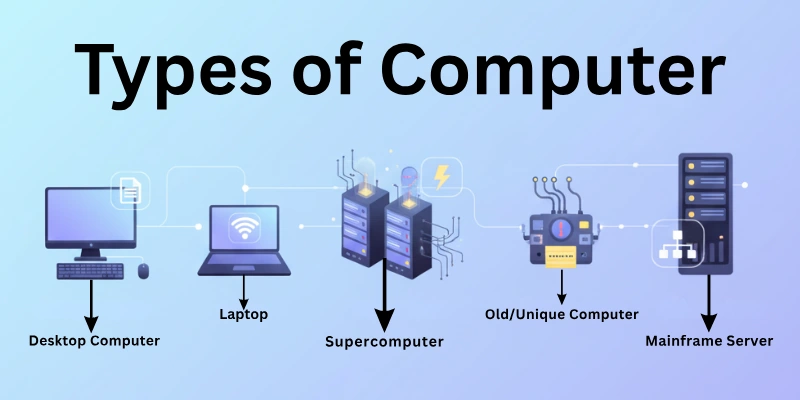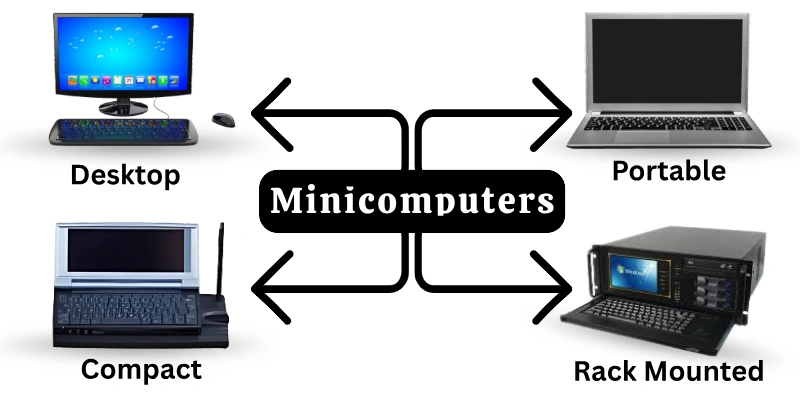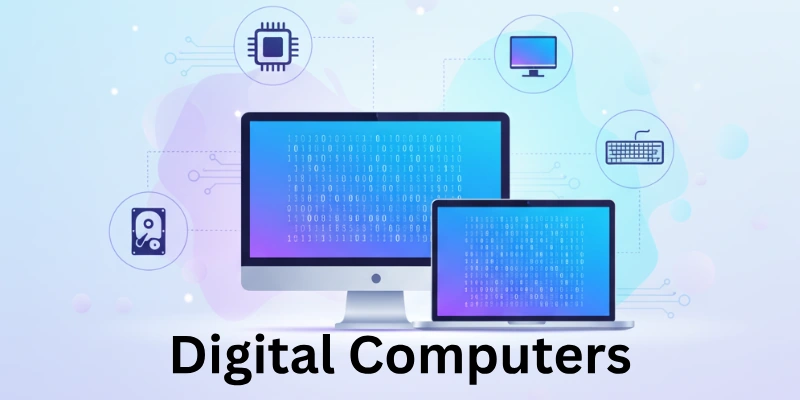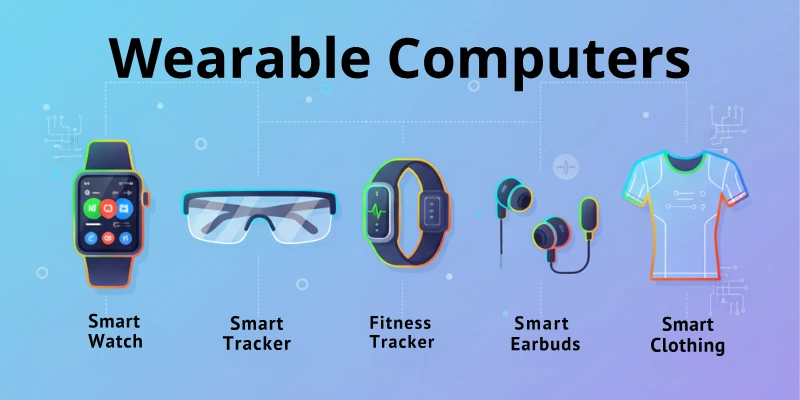Types of Computers: Overview, Uses, & Modern Trends
Published: 19 Aug 2025
Computers are part of our daily lives, but they are not all the same. From powerful machines that help scientists predict weather to the smartphones we carry in our pockets, computers come in many forms. Each type is built for a different purpose, whether it’s handling huge amounts of data, running businesses, or making everyday tasks easier. In this guide, we’ll explore the main types of computers and see how they work in different areas of life.
So, what are you waiting for? Let’s dive in with me to learn all computer types!
Types of Computer
I have grouped the types of computers into clear categories after deep research on this topic. Here are the main ones:

- Supercomputers
- Mainframe Computers
- Minicomputers
- Microcomputers (Desktops, Laptops, Tablets, Smartphones)
- General Purpose Computers
- Special Purpose Computers
- Analog Computers
- Digital Computers
- Hybrid Computers
- Embedded Computers
- Wearable Computers
- Quantum Computers
Let’s now cover each of these types in detail.
Types of Computers by Size & Power
Guys, in the above list, the computers that come under this category are:
- Supercomputers
- Mainframe Computers
- Minicomputers
- Microcomputers
Let’s now cover all these in detail.
1. Supercomputers
A supercomputer is the fastest and most powerful type of computer. It is designed to solve very complex problems that normal computers cannot handle. These machines can perform trillions of calculations in a single second. They are very large in size and need special cooling systems to work properly. Supercomputers are very expensive and mostly owned by governments or research centers. They are built to give maximum speed and power, not for daily use.
Key Features of Supercomputers
- Extremely high speed and performance.
- Very large size and storage capacity.
- Can run many complex programs at once.
- Needs special cooling and power supply.
- Very costly to build and maintain.
Uses of Supercomputers
- Weather forecasting and climate research.
- Space exploration and astronomy.
- Military research and defense systems.
- Scientific simulations like earthquakes or nuclear reactions.
- Drug discovery and medical research.
Examples of Supercomputers
- Fugaku (Japan)
- Summit (USA)
- Frontier (USA)
2. Mainframe Computers
A mainframe computer is a very powerful computer, but it is mainly used for handling and storing large amounts of data. Unlike supercomputers that focus on speed, mainframes focus on reliability and data processing. They can support hundreds or even thousands of users at the same time. Mainframes are often used by big companies, banks, and governments. They are large in size but smaller than supercomputers. These machines are built to run for years without stopping.
Key Features of Mainframe Computers
- Can handle very large amounts of data.
- Supports many users at the same time.
- Very reliable and secure.
- Strong backup and recovery systems.
- Long life and nonstop working capacity.
Uses of Mainframe Computers
- Banking and financial transactions.
- Airline reservation systems.
- Government record-keeping.
- Insurance and healthcare data storage.
- Large business operations.
Examples of Mainframe Computers
- IBM zSeries
- Unisys ClearPath Dorado
- Hitachi Mainframe Systems
3. Minicomputers
A minicomputer is smaller than a mainframe but bigger than a personal computer. It was once very popular in businesses and research labs. These computers can support multiple users at the same time. They are less costly compared to mainframes and supercomputers. Minicomputers were often used where medium power was enough. Today, they are not as common because modern personal computers are more powerful.

Key Features of Minicomputers
- Medium size and processing power.
- Can support several users at once.
- Cheaper than mainframes but stronger than PCs.
- Suitable for small to medium organizations.
- Used mostly in the past, now mostly replaced by servers and PCs.
Uses of Minicomputers
- Manufacturing and production control.
- Research laboratories.
- Small business data management.
- Educational institutions.
Examples of Minicomputers
- PDP-11 by Digital Equipment Corporation (DEC)
- VAX series
- IBM AS/400
4. Microcomputers
A microcomputer is the most common type of computer used today. It is designed for personal use by one person at a time. These computers are smaller, cheaper, and easy to use compared to mainframes or minicomputers. They are powered by a microprocessor, which is why they are called microcomputers. They are widely available for home, office, education, and entertainment. Microcomputers are the reason computers became part of daily life.
Key Features of Microcomputers
- Small size and affordable price.
- Easy to use and portable in some models.
- Runs on microprocessors.
- Supports one user at a time.
- Comes in different forms like desktop and laptop.
Uses of Microcomputers
- Home use (internet, gaming, study).
- Office work (documents, emails, presentations).
- Education and online learning.
- Business tasks and communication.
- Entertainment like movies and music.
Examples (Subtypes) of Microcomputers
- Desktops – Regular personal computers for home and office
- Laptops/Notebooks – Portable computers for work and study
- Tablets – Touchscreen computers, lightweight and easy to carry
- Smartphones – Small but powerful computers in your pocket
Types of Computers by Purpose
Here are the computer types by purpose:
- General Purpose Computers
- Special Purpose Computers
Let us learn about them in detail.
1. General Purpose Computers
A general purpose computer is designed to perform many different tasks. It is not limited to just one specific job. These computers can run a variety of programs like word processing, browsing, gaming, and more. They are flexible and used by people in homes, schools, and offices. Most personal computers we use today fall under this category. They are built for everyday use by individuals and organizations.
Key Features of General Purpose Computers:
- Can perform multiple tasks.
- Supports different software applications.
- Easy to upgrade and customize.
- Affordable and available in many forms.
- Suitable for personal, educational, and business use.
Uses of General Purpose Computers:
- Writing documents and making presentations.
- Browsing the internet and communication.
- Entertainment like movies, music, and games.
- Business tasks and office work.
- Online learning and research.
Examples of General Purpose Computers:
- Desktop computers
- Laptops
- Tablets
- Smartphones
2. Special Purpose Computers
A special purpose computer is designed to perform only one specific task. Unlike general purpose computers, it cannot be used for multiple different jobs. These computers are built with a fixed program or function in mind. They are often found inside machines or devices we use every day. Special purpose computers are faster and more efficient for their single task. However, they cannot be reprogrammed for other uses.
Key Features of Special Purpose Computers
- Built for a single specific job.
- High speed and accuracy in that job.
- Cannot be easily reprogrammed.
- Small in size and often hidden inside other devices.
- Reliable and cost-effective for the purpose they serve.
Uses of Special Purpose Computers
- ATMs for banking transactions.
- Traffic light control systems.
- Gaming consoles.
- Industrial machines.
- Medical equipment like heart rate monitors.
Examples of Special Purpose Computers
- PlayStation or Xbox (gaming consoles)
- ATM machines
- Washing machines with built-in controllers
- Digital cameras
Types of Computers by Data Handling
Here are the computer types listed according to data handling:
- Analog Computers
- Digital Computers
- Hybrid Computers
Let us cover all these types in detail.
1. Analog Computers
An analog computer works with continuous data instead of digital signals. It does not use binary numbers (0s and 1s) like modern computers. These computers measure physical values such as temperature, speed, or pressure. They are used where exact numerical calculations are less important than measurement. Analog computers were common before digital computers became popular. Today, they are mostly replaced but still used in some special areas.
Key Features of Analog Computers
- Works with continuous data (not binary).
- Provides approximate results quickly.
- Good for measuring natural values like speed or voltage.
- Simple design and faster for certain calculations.
- Limited flexibility compared to digital computers.
Uses of Analog Computers
- Aircraft flight simulators.
- Measuring speed in vehicles (speedometers).
- Scientific and engineering experiments.
- Control systems in industries.
- Thermometers and pressure gauges.
Examples of Analog Computers
- Traditional speedometer in cars
- Slide rules
- Analog voltmeters
- Early flight simulators
2. Digital Computers
A digital computer is the most common type of computer used today. It works with data in binary form, using 0s and 1s. These computers are highly accurate and reliable for calculations. They can store, process, and display information in digital format. Digital computers are found in homes, schools, offices, and industries. Almost all modern devices we use daily are digital computers.

Key Features of Digital Computers
- Works with binary numbers (0 and 1).
- Very accurate and reliable.
- Can store large amounts of data.
- Easy to program for many different tasks.
- Available in many sizes, from desktops to smartphones.
Uses of Digital Computers
- Education and online learning.
- Business operations and office work.
- Entertainment like movies, music, and gaming.
- Banking and e-commerce.
- Communication through email, chat, and video calls.
Examples of Digital Computers
- Desktop computers
- Laptops
- Tablets
- Smartphones
3. Hybrid Computers
A hybrid computer is a machine that combines the features of both analog and digital computers. It can process continuous data like an analog computer and also handle binary data like a digital computer. These computers are built to get the speed of analog and the accuracy of digital. They are used in areas where both measurement and exact calculation are needed. Hybrid computers are more powerful than analog or digital alone. They are mostly used in scientific, medical, and industrial fields.
Key Features of Hybrid Computers
- Combines analog speed with digital accuracy.
- Can work with both continuous and binary data.
- More powerful than analog or digital computers alone.
- Specially designed for advanced applications.
- Costly and less common than digital computers.
Uses of Hybrid Computers
- Hospitals for patient monitoring and diagnosis.
- Scientific research and laboratories.
- Industrial control systems.
- Aviation and defense.
- Space research.
Examples of Hybrid Computers
- Machines used in hospitals to monitor heart rate and other vital signs
- Hybrid computers used in weather forecasting centers
- Control systems in aircraft and spacecraft
Modern & Emerging Types of Computers
Here are the types of modern computers:
- Embedded Computers
- Wearable Computers
- Quantum Computers
Let us cover all these in detail.
1. Embedded Computers
An embedded computer is a small computer system built inside another device. It is designed to control specific functions of that device. These computers are not meant for general use like laptops or desktops. They usually run one program or a fixed set of tasks. Embedded computers are all around us in daily life, often hidden inside machines. They make devices smarter and easier to use.
Key Features of Embedded Computers
- Small in size and lightweight.
- Built for one or a few fixed tasks.
- Runs with low power and resources.
- Works automatically without much user control.
- Reliable and cost-effective for mass production.
Uses of Embedded Computers
- Home appliances like washing machines and microwaves.
- Cars for engine control, GPS, and safety systems.
- Mobile phones and cameras.
- Industrial machines and robots.
- Smart devices in homes and offices.
Examples of Embedded Computers
- Car engine control system
- Digital cameras
- Smart TVs
- Microwave ovens
2. Wearable Computers
A wearable computer is a small computer that you can wear on your body. It is designed to be lightweight, portable, and easy to carry all day. These computers often connect to the internet or other devices for real-time use. They help track health, fitness, and daily activities. Wearable computers are becoming more popular in modern life. They bring computing power into clothing, watches, and other personal items.

Key Features of Wearable Computers
- Small, lightweight, and portable.
- Can be worn like clothing or accessories.
- Often connected to the internet or smartphones.
- Used for health, fitness, and communication.
- Runs on batteries with wireless technology.
Uses of Wearable Computers
- Tracking health and fitness (steps, heart rate, calories).
- Navigation and real-time maps.
- Communication through calls and messages.
- Augmented reality (AR) and virtual reality (VR).
- Safety and monitoring in workplaces.
Examples of Wearable Computers
- Smartwatches like Apple Watch, Samsung Galaxy Watch
- Fitness trackers like Fitbit
- AR glasses like Google Glass
- VR headsets like Oculus
3. Quantum Computers
A quantum computer is an advanced type of computer that uses the principles of quantum mechanics. Unlike digital computers that use bits (0 and 1), quantum computers use qubits, which can be both 0 and 1 at the same time. This makes them much faster for certain complex problems. Quantum computers are still in the research stage and not commonly available. They are expected to solve problems that even supercomputers cannot handle. Scientists believe quantum computers will change the future of technology.
Key Features of Quantum Computers
- Works on qubits instead of normal bits.
- Can process massive amounts of data at high speed.
- Extremely powerful for simulations and complex tasks.
- Still in experimental and research stages.
- Requires special cooling and advanced systems to run.
Uses of Quantum Computers
- Drug discovery and medical research.
- Cryptography and cybersecurity.
- Weather and climate modeling.
- Artificial intelligence and machine learning.
- Financial modeling and risk analysis.
Examples of Quantum Computers
- Google Sycamore
- IBM Quantum Computer
- D-Wave Systems
Quick Comparison Table: Computer Types
Guys, here is a quick glance at all the differences between types of computers:
| Category | Definition | Key Uses | Examples |
|---|---|---|---|
| Supercomputers | Extremely powerful machines for complex calculations. | Weather forecasting, space research, nuclear tests. | Fugaku, Summit |
| Mainframe Computers | Large systems that handle huge data and many users. | Banking, government, airlines. | IBM zSeries, Hitachi |
| Minicomputers | Medium-sized, smaller than mainframes. | Manufacturing, research labs. | PDP-11, VAX 750 |
| Microcomputers | Personal computers like desktops and laptops. | Office work, education, entertainment. | Dell PC, MacBook, iPad, iPhone |
| General Purpose | Designed for everyday tasks. | Word processing, browsing, gaming. | Desktops, laptops |
| Special Purpose | Built for one specific task. | ATMs, washing machines, traffic lights. | ATM machines, microwave controllers |
| Analog Computers | Work with continuous signals. | Engineering, flight simulations. | Old scientific devices |
| Digital Computers | Work with binary numbers (0s and 1s). | Almost all modern computers. | PCs, laptops, smartphones |
| Hybrid Computers | Mix of analog and digital computing. | Hospitals, scientific research. | ICU monitoring systems |
| Embedded Computers | Built inside other devices. | Cars, smart TVs, appliances. | Car ECU, Smart TV processors |
| Wearable Computers | Small devices worn on the body. | Health tracking, fitness, communication. | Apple Watch, Fitbit |
| Quantum Computers | Future computers using quantum mechanics. | AI, cryptography, drug discovery. | Google Sycamore, IBM Quantum |
Which Type of Computer Do You Use Daily?
Now that we’ve explored all the types of computers, think about the one you use most often.
- If you’re on a desktop or laptop, you’re using a microcomputer.
- If you wear a smartwatch, that’s a wearable computer.
- If you rely on your smartphone, that’s also part of the microcomputer category.
- Even your car, washing machine, or TV might have embedded computers working silently inside.
So, whether it’s for work, study, fun, or health tracking — you’re surrounded by computers every single day.
Conclusion
So guys, in this article we have covered all the major types of computers in detail. From powerful supercomputers to the tiny wearable devices on our wrists, each type has its own role in our daily lives. My recommendation is to notice the kind of computer you use most often and understand how it fits into these categories — it helps you see how far technology has come.
Thanks for reading, and see you in the next guide!
FAQs
Here are some of the most commonly asked questions related to different types of computer:
The main types of computers include supercomputers, mainframes, minicomputers, and microcomputers like desktops, laptops, and smartphones. We also have analog, digital, hybrid, and embedded computers. Newer types like wearable and quantum computers are also becoming popular. Each type has a special purpose.
Supercomputers are the fastest computers in the world. They can process millions of calculations per second. These are mostly used for research, weather forecasts, and space projects. You will not see them in homes or offices.
Most people use microcomputers at home. This category includes desktops, laptops, tablets, and smartphones. They are built for everyday work like browsing, studying, and entertainment. They are small, affordable, and easy to use.
General-purpose computers are designed to do many tasks, like writing, gaming, or browsing the internet. Examples are laptops and desktops. Special-purpose computers are built for only one job, like controlling traffic lights or ATMs. They cannot be used for other tasks.
The future of computers is moving toward quantum computers and AI-powered machines. Quantum computers can solve problems that regular computers cannot handle. Wearable and embedded computers will also become more common in daily life. Technology is moving fast, and computers are getting smarter and smaller.

- Be Respectful
- Stay Relevant
- Stay Positive
- True Feedback
- Encourage Discussion
- Avoid Spamming
- No Fake News
- Don't Copy-Paste
- No Personal Attacks

- Be Respectful
- Stay Relevant
- Stay Positive
- True Feedback
- Encourage Discussion
- Avoid Spamming
- No Fake News
- Don't Copy-Paste
- No Personal Attacks





